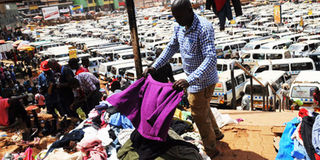Used clothes imports grow fivefold

Continued growth. A vendor displays second hand clothes for sale in Kampala. Imports of used clothes have been growing despite various moves to stop their entry in Uganda. FILE PHOTO
Uganda’s import bill of second hand clothes has increased fivefold from $27.4m (Shs102b) in 2001 to $137m (Shs511b) in 2016, a report by Economic Research Policy Centre (ERPC) indicates.
The report, “Fostering a sustainable agro-industrialisation agenda in Uganda” highlights Uganda’s performance across nine agricultural product value chains.
According to the report, worn clothing and worn textile otherwise known as second hand clothes are a major component of Uganda’s import textile bill.
“Of critical significance to note is that the worn textile products and clothing is a major component of Uganda’s import textile products, accounting for $27m in 2001 and $137m in 2016,” the report reads in part, highlighting the potential domestic market that lies untapped in the textile and apparel market.
The report indicates that in 2001, Uganda imported second hand clothes worth $27.4m, which grew to $36m (Shs134b) in 2005 and $86m (Shs320b) and $102m (Shs380b) in 2010 and 2015, respectively.
Textile import bill
Uganda’s overall textile import bill has increased by three fold from $56m in 2001 to $210m in 2016 with a cumulative sum of $657m (Shs2.4 trillion) over the years with the highest contribution from second hand clothes making up $390m (Shs1.4 trillion) representing 57.7 per cent.
Importation of new clothes “apparel and clothing products” make up $83.6m, (Shs309b) man-made staple fibres $77m (Shs287b) and other textiles accounted for $122m (Shs455b) during the period.
The report attributes the growth in textile importation to high population growth and limited local capacity for apparel production.
Importation of second hand clothes has been a contentious topic because aside from employing numerous Ugandans, foreign powers such as US have vested interests.
The East African countries, including Kenya, Uganda, Tanzania, Rwanda, and Burundi in 2016 came up with a three year plan to ban imports of second hand clothes as part of EAC vision 2050 to boost industrialisation.
However, the move raised concerns with the US threatening to review trade benefits enjoyed by EAC member states under African Growth and Opportunity Act (Agoa).
The ban was to be enforced by introducing and increasing taxes on used clothes.
However, the 2019/20 regional budgets made no mention of taxes on used clothes despite emphasising the industrialisation agenda.
In January, Uganda Ginners and Cotton Exporters Association asked government to ban importation of used clothes.
Performance of the cotton sector (exports)
While the import bill of used clothes has tripled in the last 15 years, earnings from cotton exports, the report indicates, have minimally grown from $12.8m (Shs47.7b) to only $24m (Shs89.5b) in over 15 years.
Nearly 95 per cent of Uganda’s cotton is exported as lint, the report says, which undermines opportunities for increased earnings from upgrading in the value chain.
Mr Swaibu Mbowa, a senior research fellow at EPRC, said government must invest and support the cotton industry to produce competitive products, which will tame importation of second hand clothes.
“Money should come from the budget to support cotton industries and they will apply the technology to cut down the cost of production and we will be competitive,” he said, adding: “We have installed capacity, 39 ginneries in Uganda, 18 of which lay idle while those operating are below 39 per cent capacity.”
Ministry of Finance in the 2019/20 financial year allocated Shs1 trillion to agriculture.
Used clothes imports
Year Amount
2001 $27.4m (Shs102b)
2005 $36m (Shs134b)
2010 $86m (Shs320b)
2015 $102m (Shs380b)
2016 $137m (Shs511b)




